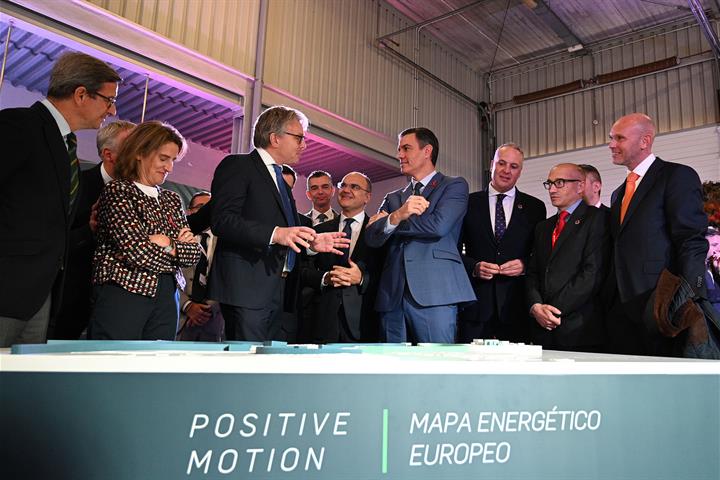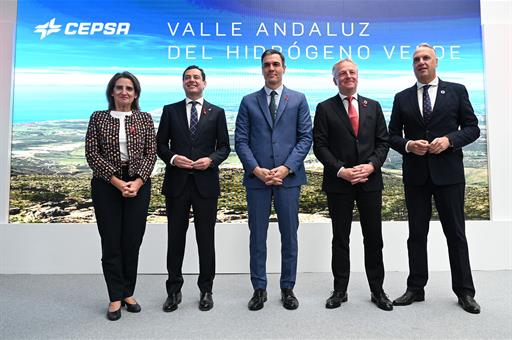The President of the Government highlights Spain's investment attractiveness in renewables and the success of the PERTE Green Hydrogen project
President's News - 2022.12.1
CEPSA Energy Park, San Roque (Cádiz)
During his speech, the Chief Executive highlighted Spain's investment attractiveness in renewable energies and "the extraordinary reception" of the Strategic Project for Economic Recovery and Transformation (PERTE) for Renewable Energies, Renewable Hydrogen and Storage. The President has announced that the provisional resolutions of the first PERTE aid programmes amount to €250 million and that "the result could not be more encouraging, because it involves the mobilisation of a total investment of €890 million in 29 projects. What do all these figures mean? What do they tell us? Above all, the huge appetite there is for investment in green hydrogen in Spain."
By 2050, this new technology will account for one third of the fuel used in global land transport and 60% of maritime transport and will also be instrumental in storing energy from a 100% renewable electricity system. The Government of Spain's commitment to this technology is firm and is materialised in the Hydrogen Roadmap for 2030, the alignment with the REPower EU Plan and with the PERTE for Renewable Energies, Renewable Hydrogen and Storage, endowed with €6.9 billion of public funds, 22% of which will be expressly dedicated to hydrogen.
Investors have confidence in Spain
The Third Vice-President of the Government and Minister for Ecological Transition and the Demographic Challenge, Teresa Ribera, also attended the event, at which the President of the Junta de Andalucía, Juan Manuel Moreno, and the CEO of Cepsa, Marteen Wetselaar, were also present. "Today Spain is recognised and recognisable as a global leader in terms of ecological transition and the fight against climate change. Investors and multinational companies know this and have confidence in our country, which has become one of the main recipients of investment in so-called green sectors, including renewable energies, batteries and storage, decarbonised industry and electric cars," stressed the President, who also recalled the recent decision by the shipping company Maersk to establish a large hub in Spain for the production of green methanol and ammonia for hydrogen-based maritime fuels.
The Executive's strategy, which includes allocating €2.3 billion of the €7 billion in pending transfers from the Recovery Plan for the energy transition, has helped to boost Spain's energy transition commitment. Pedro Sánchez pointed out that the government eliminated the sun tax and approved the National Integrated Energy and Climate Plan and the Climate Change law. Since then, renewables have increased their contribution to electricity generation from 32% in 2017 to 47% in 2021. Spain is the fifth country in the world in wind energy, the eighth in renewable generation and of all green hydrogen projects worldwide, 20% are located in Spain, which is second only to the United States.
 The President of the Government of Spain, Pedro Sánchez, during his visit to the CEPSA Energy Park in San Roque (Cádiz) | Pool Moncloa/Borja Puig de la Bellacasa
The President of the Government of Spain, Pedro Sánchez, during his visit to the CEPSA Energy Park in San Roque (Cádiz) | Pool Moncloa/Borja Puig de la Bellacasa
Lowest inflation in the Eurozone thanks to government measures
"We are committed to hydrogen storage, biogas, through specific strategies for these technologies. And in Brussels - and the Vice-President of the Government, Teresa Ribera, was there, too - we fought hard to reform a European electricity market that needs to be reformed. And we have also implemented a solution, which we have called the Iberian solution, jointly with Portugal", the Chief Executive continued
To this effect, Pedro Sánchez highlighted that, thanks to the package of measures adopted by the government, Spain is the country with the lowest inflation in the Eurozone, 3.4 points below the European average. "Spain, despite the difficulties, is moving forward. It is moving forward by reducing and bending the inflation curve; by creating better jobs; by protecting the middle classes and workers and reindustrialising our country; and by making the most of the opportunities and advantages offered by this digital transformation and this ecological transition," he said.
Boosting interconnections
Cepsa's project to produce green hydrogen in Andalusia will involve the creation of the first European corridor for this technology, between the Campo de Gibraltar and the Dutch port of Rotterdam. The multinational will invest €3 billion, and the project will create 10,000 direct and indirect jobs and avoid the emission of three million tonnes of CO2 per year. "This investment will help Spain achieve its goal of becoming an energy exporter, which is one of our passions. We want to make Spain an energy exporting country", said the Chief Executive.
Sanchez stressed that this project will facilitate Spain's access to the Delta Green Corridor, which connects Rotterdam with other European industrial clusters in Germany, the Netherlands and Denmark. "We have an extensive network of natural gas, liquefied natural gas, which can be adapted for the transport and supply of green hydrogen, thanks to the ambitious interconnection policy. The agreement we have reached with France and Portugal to build this Iberian hydrogen corridor, which we have called BarMar, could allow us to export 20% of the estimated production of the European Union as a whole by 2030", Sánchez highlighted.
Non official translation





